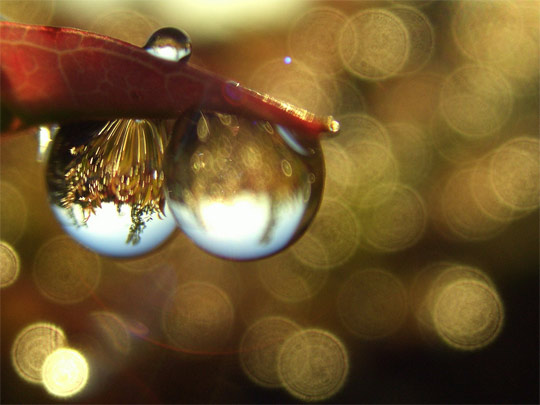Doug Kerr
Well-known member
[Part 1]
Introduction
We tend to use the term "depth of field" to refer to two quite different, although related, issues:
• Depth of field [DoF]
• Out-of-focus blur performance (OFB)
With regard to depth of field, we ask this question:
With regard to out-of-focus blur performance, we ask this question:
In connection with each of these matters, we may be interested in the implications of the use of different sensor sizes.
Depth of field
In calculating the depth of field to be experiences in any given camera setup, we must deal with the question "how do we quantify 'amount of blurring' " and how do we decide what is 'acceptable' "?
We normally use as the numerical indicator of amount of blurring the diameter of the circle of confusion, the "blur figure" created from a point on the object in the case of imperfect focus, on the focal plane. We impose our view of how much blur is "acceptable" by establish a limit on this diameter, called the circle of confusion diameter limit (COCDL).
Approach A: Visual perception
Here we say that acceptable blurring is blurring that is not significantly perceptible to the viewer of the image. Of course that is a best an arbitrary judgement, but the important fact is that this must be expressed expressed in terms of the angular diameter of the circle of confusion as measured from the eye.
But to calculate depth of field, we must adopt a COCDL, which is measured as a distance on the focal plane. To relate the two, we must adopt (probably arbitrarily) some ratio between the size of the viewed image and the size of the image on the focal plane, plus a viewing distance.
The need for this (often) arbitrary assumption of the viewing context is often cited as a reason not to adopt traditional values of COCDL (such as "1/1400 of the diagonal size of the image on the focal plane").
Approach B: Degradation of resolution
Here, we define acceptable blurring as that which does not significantly degrade the resolution of the camera. Again, what diameter of the circle of confusion, compare to the resultion of the camera "in perfect focus", constitutes "significant degradation" is rather arbitrary, but a practical interpretation is to use for COCDL some small multiple (maybe 1x, maybe 2x) of the sensel pitch.
What is the advantage of using this approach over Approach A? Well, one advantage is that we don't have to think about the viewing environment.
In most cases, depth of field calculated using a COCDL developed under this approach will be less than when using a COCDL developed under Approach A.
The irony
Of course the irony here is that regardless of the approach we take with respect to the COCDL to be used for reckoning the depth of field, or the COCDL value we adopt, the image will look identical for any given setup of subjects. The camera of course has no idea what COCDL we would use when calculating depth of field, or how we got it. Depth of field is a creature of our outlook on what a given optical setup does, not an innate property of the optical result.
Effect of sensor size
We often ask, "if I go from a sensor size of 27 mm (diagonal) to 43 mm, what will that do to the calculated depth of field, 'all other factors remaining equal' "?
Well it is that latter qualification than must be carefully thought out. A reasonable prescription might include these:
• Focal length that gives a comparable field of view
• Same focus distance
But we also need to make some decisions about the COCDL to be used as an input to the calculation.
If we are "Approach A" believers (this is a largely ideological issue), then a reasonable choice would be:
A: Use a COCDL that is a consistent fraction of the sensor dimensions.
But suppose we believe in Approach B? Well, we might do various things. Let's say we will not want to consider the actual resolutions of two cameras being compared, but just want a "generic" result.
Then we might:
B1: Assume that the two cameras have the same resultion in terms of cycles per mm, or
B2: Assume that the two cameras have the same resultion in terms of cycles per image height
Oh. boy!
Well, lets see what happens. We will start with a camera with a 27 mm sensor ("APS-C"), with the following setup:
• Focal length: 50 mm
• Focus distance: 10 m
• Aperture: f/4.0
We will start with a COCDL of 1/1400 of the sensor diagonal size (0.019 mm).
The calculated depth of field (double-sided) would be 6.66 m.
Now we consider the use of a camera with a 43 mm sensor size ("35-mm full-frame"), with the:"same setup" (as defined above). Now, depending on the approach we take regarding COCDL, the calculated depth of field would be:
A: 4.03 m [0.61 times the original value]
B1: 2.41 m [0.36 times the original value]
B2: 4.03 m [0.61 times the original value]
In Part 2, we will do a similar exercise with regard to out-of-focus blur performance.
Time now for breakfast.
[to be continued]
Introduction
We tend to use the term "depth of field" to refer to two quite different, although related, issues:
• Depth of field [DoF]
• Out-of-focus blur performance (OFB)
With regard to depth of field, we ask this question:
For a given camera "setup", over what range of subject feature distances will the subject feature be imaged with "acceptable" blurring due to imperfect focus.
With regard to out-of-focus blur performance, we ask this question:
For a given camera setup, how much will a "foreground" or "background" subject feature at a certain distance be blurred.
In connection with each of these matters, we may be interested in the implications of the use of different sensor sizes.
Depth of field
In calculating the depth of field to be experiences in any given camera setup, we must deal with the question "how do we quantify 'amount of blurring' " and how do we decide what is 'acceptable' "?
We normally use as the numerical indicator of amount of blurring the diameter of the circle of confusion, the "blur figure" created from a point on the object in the case of imperfect focus, on the focal plane. We impose our view of how much blur is "acceptable" by establish a limit on this diameter, called the circle of confusion diameter limit (COCDL).
This is the number often called just "circle of confusion", an inappropriate and misleading usage.
But how might we choose what value of COCDL to use? The are two popular underlying approaches:Approach A: Visual perception
Here we say that acceptable blurring is blurring that is not significantly perceptible to the viewer of the image. Of course that is a best an arbitrary judgement, but the important fact is that this must be expressed expressed in terms of the angular diameter of the circle of confusion as measured from the eye.
But to calculate depth of field, we must adopt a COCDL, which is measured as a distance on the focal plane. To relate the two, we must adopt (probably arbitrarily) some ratio between the size of the viewed image and the size of the image on the focal plane, plus a viewing distance.
The need for this (often) arbitrary assumption of the viewing context is often cited as a reason not to adopt traditional values of COCDL (such as "1/1400 of the diagonal size of the image on the focal plane").
Approach B: Degradation of resolution
Here, we define acceptable blurring as that which does not significantly degrade the resolution of the camera. Again, what diameter of the circle of confusion, compare to the resultion of the camera "in perfect focus", constitutes "significant degradation" is rather arbitrary, but a practical interpretation is to use for COCDL some small multiple (maybe 1x, maybe 2x) of the sensel pitch.
What is the advantage of using this approach over Approach A? Well, one advantage is that we don't have to think about the viewing environment.
In most cases, depth of field calculated using a COCDL developed under this approach will be less than when using a COCDL developed under Approach A.
The irony
Of course the irony here is that regardless of the approach we take with respect to the COCDL to be used for reckoning the depth of field, or the COCDL value we adopt, the image will look identical for any given setup of subjects. The camera of course has no idea what COCDL we would use when calculating depth of field, or how we got it. Depth of field is a creature of our outlook on what a given optical setup does, not an innate property of the optical result.
Effect of sensor size
We often ask, "if I go from a sensor size of 27 mm (diagonal) to 43 mm, what will that do to the calculated depth of field, 'all other factors remaining equal' "?
Well it is that latter qualification than must be carefully thought out. A reasonable prescription might include these:
• Focal length that gives a comparable field of view
• Same focus distance
But we also need to make some decisions about the COCDL to be used as an input to the calculation.
If we are "Approach A" believers (this is a largely ideological issue), then a reasonable choice would be:
A: Use a COCDL that is a consistent fraction of the sensor dimensions.
But suppose we believe in Approach B? Well, we might do various things. Let's say we will not want to consider the actual resolutions of two cameras being compared, but just want a "generic" result.
Then we might:
B1: Assume that the two cameras have the same resultion in terms of cycles per mm, or
B2: Assume that the two cameras have the same resultion in terms of cycles per image height
Oh. boy!
Well, lets see what happens. We will start with a camera with a 27 mm sensor ("APS-C"), with the following setup:
• Focal length: 50 mm
• Focus distance: 10 m
• Aperture: f/4.0
We will start with a COCDL of 1/1400 of the sensor diagonal size (0.019 mm).
The calculated depth of field (double-sided) would be 6.66 m.
Now we consider the use of a camera with a 43 mm sensor size ("35-mm full-frame"), with the:"same setup" (as defined above). Now, depending on the approach we take regarding COCDL, the calculated depth of field would be:
A: 4.03 m [0.61 times the original value]
B1: 2.41 m [0.36 times the original value]
B2: 4.03 m [0.61 times the original value]
In Part 2, we will do a similar exercise with regard to out-of-focus blur performance.
Time now for breakfast.
[to be continued]












